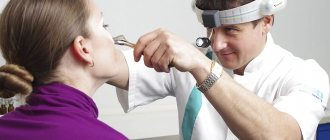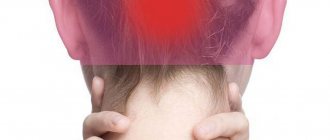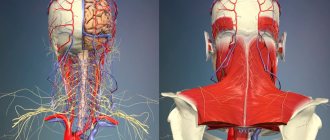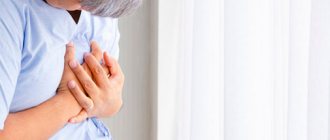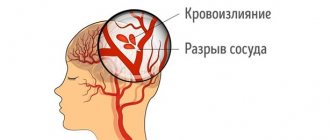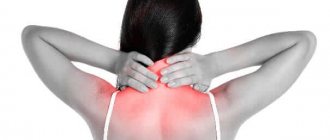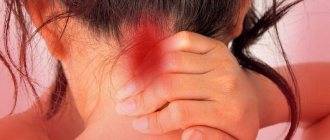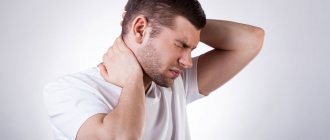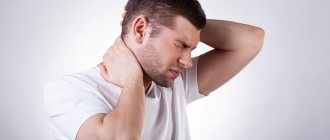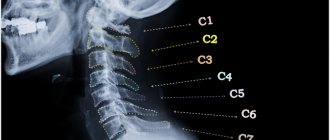Causes of pain in the back of the head on the right side of the head
If you have a headache in the back of your head on the right, it is important to find out the exact cause of this symptom. It is worth understanding that it can also manifest itself in a healthy person. Stress, physical and mental fatigue, high air pollution and other factors can provoke ischemia of certain areas of the brain and pain in the occipital part of the head on the right. However, examination may reveal acute and chronic diseases that cause headaches in the back of the head on the right.
Inflammation of the occipital nerve
The greater occipital nerve originates from the second cervical nerve and passes under the base of the skull. It follows to the scalp through the muscles of the neck and back of the head. Neuralgia can be a consequence of inflammation or mechanical damage to nerve fibers. Its causes are injuries and chronic diseases of the cervical spine, constant muscle spasms. The following factors can also trigger the disease:
- incorrect posture;
- uneven neck position when sitting for a long time;
- intense physical activity.
With occipital neuralgia, pain can be constant or paroxysmal. The patient has pain on the right side of the back of the head, discomfort spreads to the front, temple and eyeball. Most often, painful sensations are concentrated only on the left or right side, but they can be symmetrical. Treatment is with anti-inflammatory drugs, antibiotics and muscle relaxants.
High blood pressure
If the occipital part of the head on the right hurts, you should immediately measure your blood pressure. Many patients have hypertension - an increase in pressure more than 120/80 mm. rt. Art. This is an acute or chronic condition that is dangerous due to the high load on the heart muscle and the gradual weakening of blood vessels. The disease can be caused by chronic arterial diseases, atherosclerosis, and dysregulation of vascular tone. It manifests itself with characteristic symptoms:
- pain on the right or left side of the back of the head;
- redness of the skin and mucous membranes;
- the appearance of small pinpoint hemorrhages under the skin;
- dizziness, fainting is possible during an acute attack.
Headaches in the right back of the head can be caused by increased intracranial pressure. This value cannot be measured independently, so the diagnosis is made based on indirect symptoms. It represents the total pressure of blood, cerebrospinal fluid and brain tissue. Its increase causes chronic headaches, dizziness, fainting, and also dangerous ischemia of certain parts of the brain. Treatment is symptomatic and includes medications to reduce blood pressure and remove excess fluid from the body.
Cervical migraine
Pain in the back of the head on the right or left is a characteristic symptom of cervical migraine. The disease is caused by impaired blood flow through the vertebral artery, which may be due to abnormalities in its structure, mechanical compression, or other factors. Its main cause is damage to the roots of the 1st, 2nd and 3rd spinal nerves, which are normally located around the vertebral artery. Cervical migraine can accompany the following diseases:
- osteochondrosis is a chronic degenerative disease in which thinning and destruction of intervertebral cartilage and deformation of bone segments occur;
- spondylosis – fusion of two adjacent vertebrae, as a result of which the damaged area loses mobility;
- injuries of the cervical spine, as well as their consequences (improper fusion of bones, formation of calluses);
- lymphadenitis - inflammation of the lymph nodes in the neck;
- stenosis (narrowing) of the vertebral artery.
With cervical migraine, the patient has a headache in the back of the head on the right or left. The pain is acute, accompanied by blurred vision, increased heart rate, weakness, and dizziness. They go away if the main cause of the disturbance in blood flow in the vertebral artery is eliminated. Physiotherapy sessions, medications to improve blood supply to the brain, and painkillers are also prescribed.
Myogelosis of the trapezius muscle
Myogelosis is a thickening of muscle tissue. It can occur not only in the trapezius, but also in any other skeletal muscle, often diagnosed in the cervical spine. Its causes are injuries, prolonged exposure to a forced unnatural position, and intense physical activity. It can also occur as a result of osteochondrosis, protrusions and intervertebral hernias.
Pain in the occipital region on the right is a characteristic sign of myogelosis of the trapezius muscle. They are also localized directly at the site of compaction, and the skin over this area may become inflamed and acquire a red tint. The patient is concerned about painful sensations, as well as nausea, dizziness, limited mobility of the neck and shoulder girdle. Treatment is prescribed individually. The regimen may include massage, physiotherapy, muscle relaxants, as well as local medications (ointments, gels) with analgesic and anti-inflammatory effects.
Vascular disorders
Spasm of the arteries carrying blood to the brain is one of the common reasons why the right side of the back of the head hurts. The condition is a narrowing of the lumen of the vessel, as a result of which blood does not flow to the tissues in sufficient quantities. Spasm can have two main causes:
- neurogenic - a violation of the central regulation of vascular tone caused by pathologies of the nervous system;
- mechanical - compression of the vessel or the appearance of obstacles on their inner wall.
Vascular spasm caused by neurogenic causes occurs abruptly. Tension of the artery wall causes a narrowing of its lumen, and blood pressure rises. The condition leads to acute headache and dizziness, and is also dangerous for the rupture of an important vessel. During an attack, bed rest and limited physical activity are recommended.
If the patient often has pain in the right occipital part of the head, this may indicate chronic mechanical compression of the vessel. The condition is caused by diseases of the cervical spine, osteochondrosis, spondylosis and other pathologies. If the pressure comes from outside, it is important to eliminate the cause and restore normal blood flow. However, narrowing of the artery lumen can be caused by atherosclerosis, in which deposits and plaques form on the inner wall. In this case, it is necessary to limit exercise, monitor blood pressure, follow a diet and take medications to correct lipid metabolism.
Why does the right back of my head hurt?
Pain always indicates a deterioration in blood supply or nerve conduction.
The cause is focal pinching of nerves and blood vessels due to displacement of the vertebrae and a decrease in the height of the intervertebral discs. In this case, a long-term pathological condition provokes a number of serious diseases:
- Hypertension.
- Increased intracranial pressure.
- Osteochondrosis of the cervical spine.
To prevent such conditions, the correct position of the structures of the spinal column and the tone of the muscle frame are restored.
It is worth remembering that the human nervous system covers the entire body, and often the source of damage is in a completely opposite area.
Therefore, a comprehensive examination is important, and not just work on the affected area.
Diagnostic methods
Timely diagnosis will allow you to determine the exact cause of pain in the right side of the back of the head and begin treatment. This will require an examination by a therapist, neurologist, traumatologist or other specialists as indicated. Additional examinations are also prescribed that are aimed at detecting or excluding specific diseases:
- X-ray of the cervical spine is the main method for diagnosing injuries, fusion of the vertebrae, and their deformation;
- MRI, CT of the neck and head are the most accurate, informative methods, thanks to which you can detect diseases of blood vessels and soft tissues, as well as neoplasms, cysts, aneurysms;
- blood tests will show the presence of an inflammatory process, and will also indicate diseases of the internal organs;
- Dopplerography - examination of blood vessels using ultrasound after adding a contrast agent.
A simple examination will not help determine the reasons why the right back of the head hurts. This will require various instrumental examinations and analyses, the accuracy of which depends on the quality of the equipment and the qualifications of specialists. The Clinical Brain Institute has modern equipment for diagnosing diseases of the neck and head, and also employs doctors with many years of experience. This makes it possible to identify complex diseases in the early stages and successfully treat them without complications.
Treatment
If the back of your head hurts, there is numbness on the right side, and at the same time you feel strong muscle tension, in our Center you can always visit the necessary specialists.
And you should start by restoring the position of the spinal column using spinal traction.
The procedure is aimed at returning the physiological position of the vertebrae, reducing the load on the cervical spine, as well as stabilizing blood circulation and nerve conduction.
In this case, the safest method is water stretching, since treatment in water promotes a gentle effect and additional relaxation of the muscles.
Treatment of pain in the back of the head
Pain in the right occipital part of the head is not a separate disease, but one of the symptoms of a number of pathologies. The set of techniques will include techniques to relieve symptoms and to eliminate the main cause of pain in the back of the head on the right. Most of them are available at home, but are carried out only with a doctor's prescription.
- Drug treatment is the main stage. The patient is prescribed muscle relaxants, drugs to correct blood pressure, substances to improve blood supply and nutrition to the brain. Additionally, medications may be prescribed to improve lipid metabolism and remove bad cholesterol, and medications to nourish intervertebral cartilage.
- Massage and physical therapy are an important step for neck diseases, spinal curvatures, and osteochondrosis. You can do it yourself, at home, but massage is only effective if performed by a specialist.
- Diet is necessary for atherosclerosis, osteochondrosis and other diseases. The patient's diet should contain a large amount of fiber and vitamins. You should avoid spicy, fatty foods, and excess animal products.
- Physiotherapy is effective for muscle and vascular spasms, chronic diseases of the cervical spine. The procedures are carried out in a course, with an interval of several days. Exposure to heat, laser, ultrasound, electric current or magnetic radiation stimulates blood circulation and regeneration processes.
In most cases, treatment is carried out with medications that the patient must take at home. However, in case of exacerbation of diseases, suspicion of the development of complications, as well as for additional diagnostics, the Clinical Institute of the Brain has the possibility of inpatient treatment and examination. This allows you to be under the supervision of qualified doctors and staff around the clock and accurately track the dynamics of disease development.
Diagnostics
If you experience severe neck pain, you should contact a neurologist or vertebrologist as soon as possible. By examining, palpating and performing certain neurological tests, the doctor will be able to detect changes in the spine and determine the causes of their occurrence. But for a more accurate diagnosis, as well as determining the extent of pathological changes, additional procedures will be required. These may include:
- X-ray is the simplest method for diagnosing disorders in the condition of bone structures, allowing to diagnose compression fractures, spondylosis and detect indirect signs of other diseases;
- CT is a more advanced diagnostic method than x-rays, which provides more detailed information about the condition of bone structures;
- MRI is the best way to detect pathological changes in soft tissue structures, in particular intervertebral discs, allowing to detect protrusions from 1 mm, not to mention intervertebral hernias and more serious changes.
If disturbances in the functioning of organs are detected as a result of compression of the spinal roots, laboratory tests are required. Patients may be prescribed a general and biochemical blood test, a study of hormone levels, etc.
Ways to prevent headaches
Pain in the right occipital part of the head can be prevented at home. To do this, you should follow several rules recommended by doctors:
- monitor your posture while walking and working in a sitting position;
- devote time to physical activity every day, carry out moderate loads;
- get rid of excess weight - it becomes a source of problems with joints, blood vessels, and metabolic disorders;
- Maintain a healthy diet with sufficient vitamins and minerals.
Pain in the back of the head on the right is a symptom that is important to pay attention to in time. Doctors at the Clinical Institute of the Brain recommend contacting for diagnosis at the initial stages. Most diseases that cause headaches can progress and lead to dangerous consequences. However, this can be prevented if the cause is addressed in the early stages.
Clinical Brain Institute Rating: 5/5 — 17 votes
Share article on social networks
Inflammatory diseases of the gastrointestinal tract
Pain and cramps in the right side can be caused by a whole “bouquet” of inflammatory processes in the gastrointestinal tract. “These are, for example, appendicitis, diverticulitis, colitis, gastroenteritis, stomach and duodenal ulcers,” says Bulat Yunusov.
Most often, with these diagnoses, the pain is felt as aching, moderate, with gradually increasing intensity. With appendicitis, pain may increase when walking, coughing, changing body position and decrease at rest. Also with this diagnosis, there is an increase in temperature, nausea, and vomiting.
With a stomach ulcer, the pain becomes more noticeable after eating fatty, spicy or fried foods, alcohol, and intense physical activity. Additional symptoms may include heartburn, nausea, and vomiting.
With colitis (inflammation of the intestines), the pain can be nagging or paroxysmal. The disease is also accompanied by diarrhea, fever, general weakness, headaches, and the presence of mucus in the stool.
With diverticulitis (protrusion of the intestinal walls), acute pain is felt to the right of the navel, the temperature rises, and diarrhea (with blood and mucus) appears.
With gastroenteritis (inflammation of the mucous membrane of the stomach and small intestine), pain in the right side is accompanied by lack of appetite, nausea, vomiting, abdominal cramps, etc.
With pancreatitis (inflammation of the pancreas), the pain begins suddenly and is constant and intense. Sometimes it can “give” to the left side or get worse after eating heavy, fatty or spicy foods.
Diseases of the urinary system
Often the side on the right side hurts due to the organs of the excretory system. “These include urolithiasis and pyelonephritis,” says Bulat Yunusov.
Pyelonephritis is an inflammatory disease of the kidneys, in which, in addition to pain in the right side, weakness, nausea, vomiting, “jumping” pulse, dry mouth, and high temperature may also occur.
Pain in the side due to urolithiasis can be constant or wave-like, dull or sharp, it can only bother you at rest or intensifies when walking. It depends on the location of the stone, but sometimes the pain may first be felt in the lumbar region (so-called “renal colic”), and only then “settle” in the right side.
